Evaluating Mitigation and Geoengineering Strategies for Climate
VerifiedAdded on 2022/09/07
|7
|1540
|15
Report
AI Summary
This report examines various mitigation and geoengineering strategies aimed at addressing climate change on a global scale. It discusses methods such as carbon filtering, afforestation, the use of technology (including electric vehicles), snow forest clearance, marine cloud brightening, carbon capture and storage, and biochar technology. The report highlights the importance of global efforts in combating greenhouse gas emissions and explores innovative approaches to minimize temperature rise. It also touches upon the ethical considerations and potential drawbacks of certain geoengineering techniques, such as the impact of snow forest clearance on Arctic ecosystems and the link between carbon capture and enhanced oil recovery. The author reflects on the need for stricter governmental regulations and the adoption of sustainable practices by organizations to protect the environment.
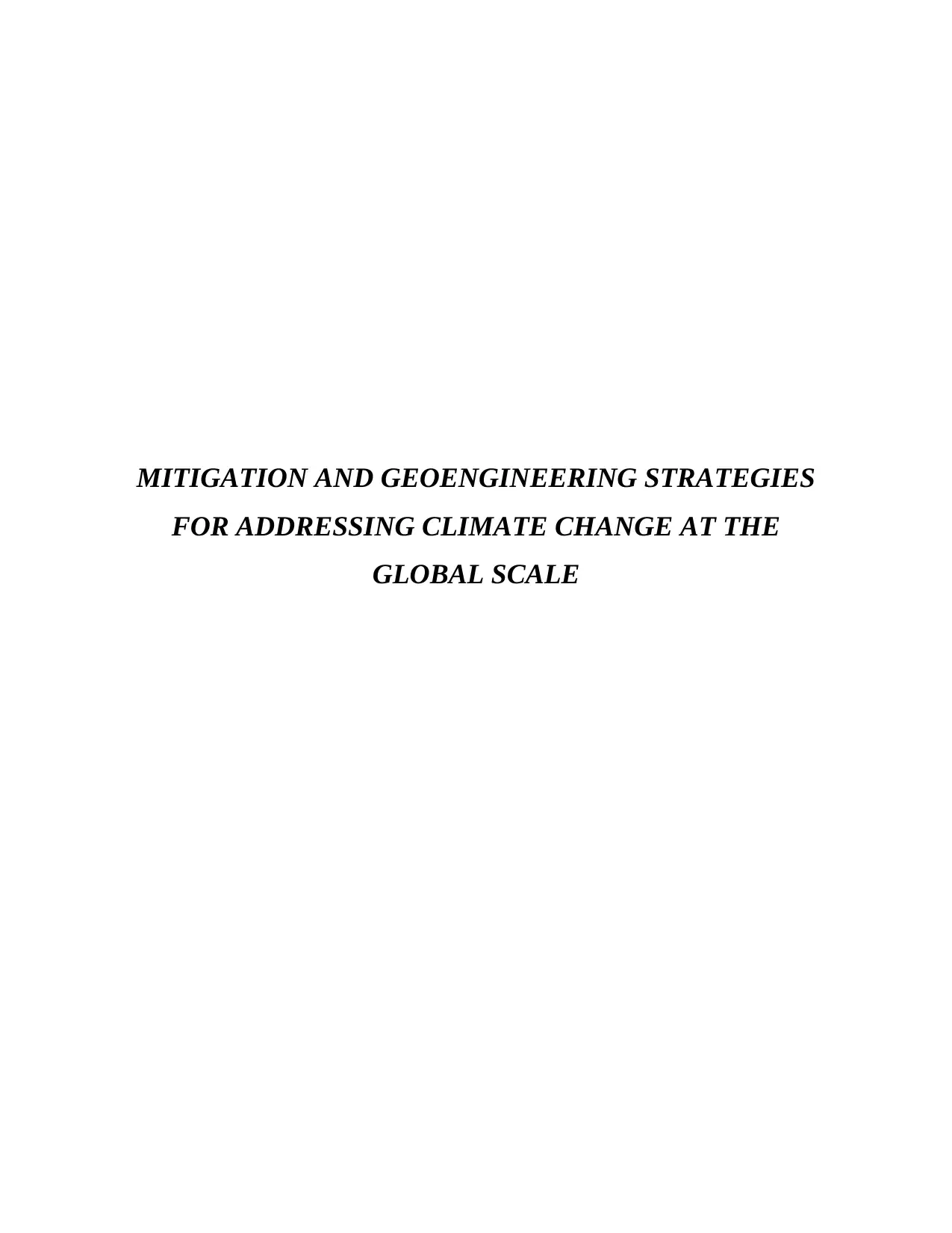
MITIGATION AND GEOENGINEERING STRATEGIES
FOR ADDRESSING CLIMATE CHANGE AT THE
GLOBAL SCALE
FOR ADDRESSING CLIMATE CHANGE AT THE
GLOBAL SCALE
Secure Best Marks with AI Grader
Need help grading? Try our AI Grader for instant feedback on your assignments.
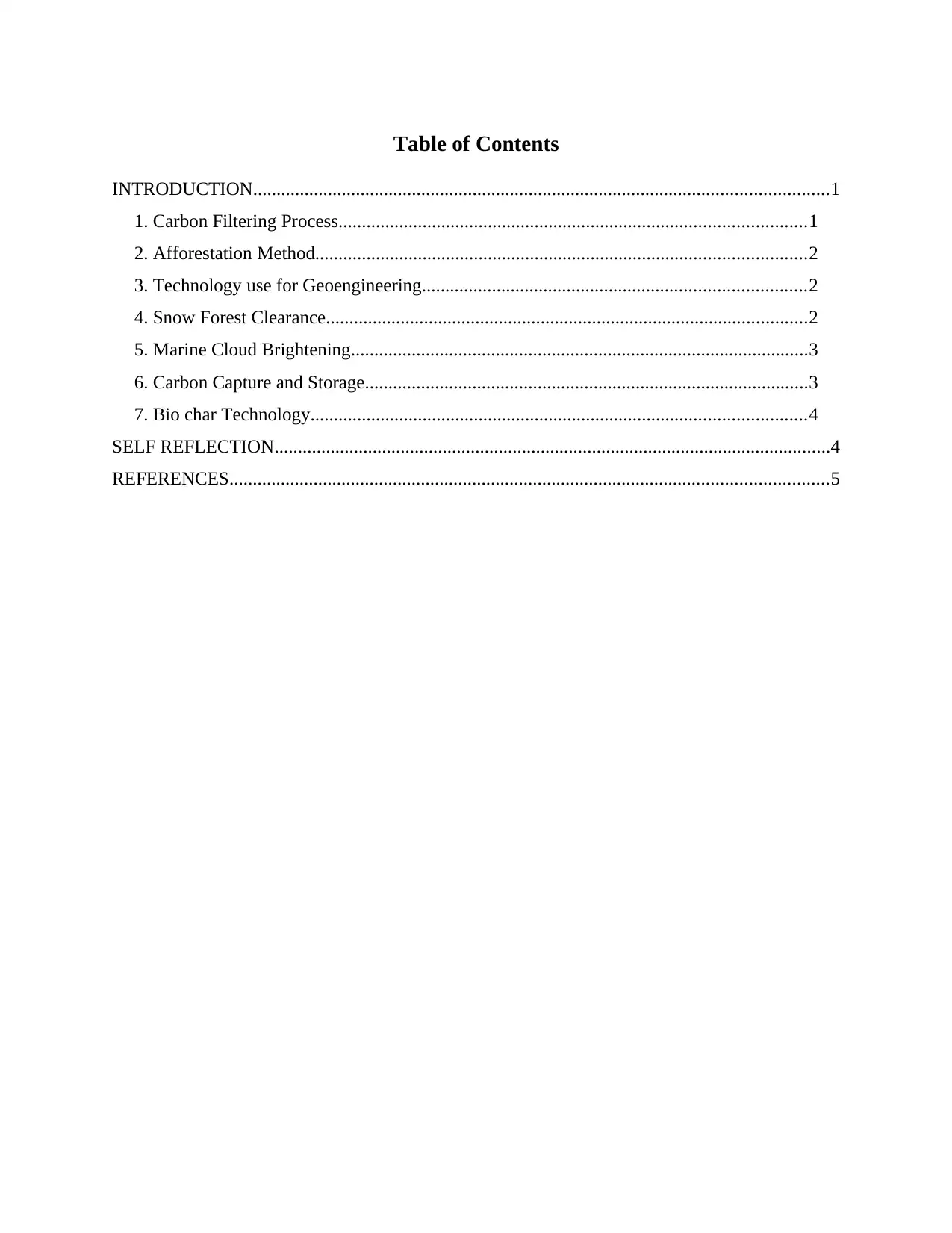
Table of Contents
INTRODUCTION...........................................................................................................................1
1. Carbon Filtering Process....................................................................................................1
2. Afforestation Method.........................................................................................................2
3. Technology use for Geoengineering..................................................................................2
4. Snow Forest Clearance.......................................................................................................2
5. Marine Cloud Brightening..................................................................................................3
6. Carbon Capture and Storage...............................................................................................3
7. Bio char Technology..........................................................................................................4
SELF REFLECTION.......................................................................................................................4
REFERENCES................................................................................................................................5
INTRODUCTION...........................................................................................................................1
1. Carbon Filtering Process....................................................................................................1
2. Afforestation Method.........................................................................................................2
3. Technology use for Geoengineering..................................................................................2
4. Snow Forest Clearance.......................................................................................................2
5. Marine Cloud Brightening..................................................................................................3
6. Carbon Capture and Storage...............................................................................................3
7. Bio char Technology..........................................................................................................4
SELF REFLECTION.......................................................................................................................4
REFERENCES................................................................................................................................5
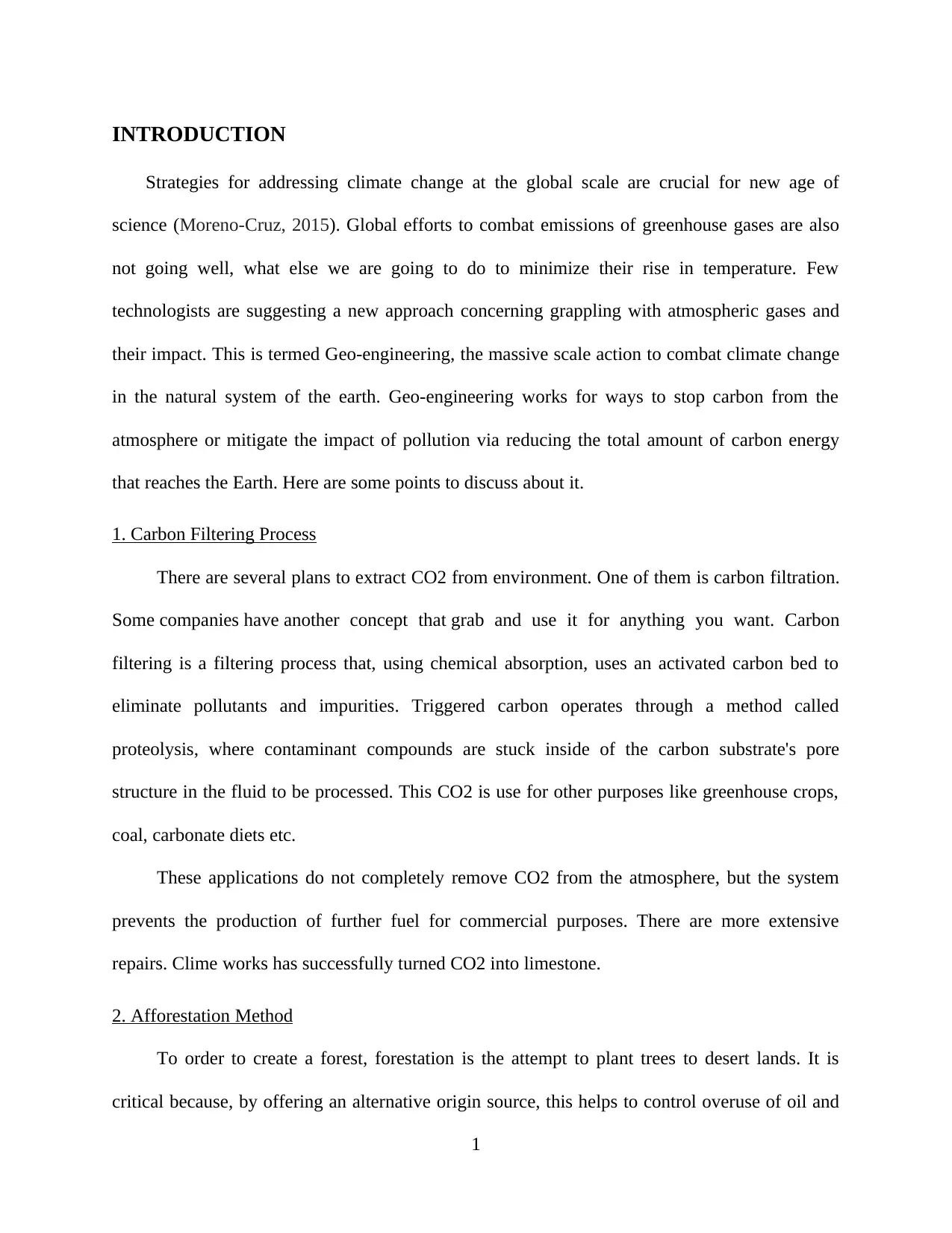
INTRODUCTION
Strategies for addressing climate change at the global scale are crucial for new age of
science (Moreno-Cruz, 2015). Global efforts to combat emissions of greenhouse gases are also
not going well, what else we are going to do to minimize their rise in temperature. Few
technologists are suggesting a new approach concerning grappling with atmospheric gases and
their impact. This is termed Geo-engineering, the massive scale action to combat climate change
in the natural system of the earth. Geo-engineering works for ways to stop carbon from the
atmosphere or mitigate the impact of pollution via reducing the total amount of carbon energy
that reaches the Earth. Here are some points to discuss about it.
1. Carbon Filtering Process
There are several plans to extract CO2 from environment. One of them is carbon filtration.
Some companies have another concept that grab and use it for anything you want. Carbon
filtering is a filtering process that, using chemical absorption, uses an activated carbon bed to
eliminate pollutants and impurities. Triggered carbon operates through a method called
proteolysis, where contaminant compounds are stuck inside of the carbon substrate's pore
structure in the fluid to be processed. This CO2 is use for other purposes like greenhouse crops,
coal, carbonate diets etc.
These applications do not completely remove CO2 from the atmosphere, but the system
prevents the production of further fuel for commercial purposes. There are more extensive
repairs. Clime works has successfully turned CO2 into limestone.
2. Afforestation Method
To order to create a forest, forestation is the attempt to plant trees to desert lands. It is
critical because, by offering an alternative origin source, this helps to control overuse of oil and
1
Strategies for addressing climate change at the global scale are crucial for new age of
science (Moreno-Cruz, 2015). Global efforts to combat emissions of greenhouse gases are also
not going well, what else we are going to do to minimize their rise in temperature. Few
technologists are suggesting a new approach concerning grappling with atmospheric gases and
their impact. This is termed Geo-engineering, the massive scale action to combat climate change
in the natural system of the earth. Geo-engineering works for ways to stop carbon from the
atmosphere or mitigate the impact of pollution via reducing the total amount of carbon energy
that reaches the Earth. Here are some points to discuss about it.
1. Carbon Filtering Process
There are several plans to extract CO2 from environment. One of them is carbon filtration.
Some companies have another concept that grab and use it for anything you want. Carbon
filtering is a filtering process that, using chemical absorption, uses an activated carbon bed to
eliminate pollutants and impurities. Triggered carbon operates through a method called
proteolysis, where contaminant compounds are stuck inside of the carbon substrate's pore
structure in the fluid to be processed. This CO2 is use for other purposes like greenhouse crops,
coal, carbonate diets etc.
These applications do not completely remove CO2 from the atmosphere, but the system
prevents the production of further fuel for commercial purposes. There are more extensive
repairs. Clime works has successfully turned CO2 into limestone.
2. Afforestation Method
To order to create a forest, forestation is the attempt to plant trees to desert lands. It is
critical because, by offering an alternative origin source, this helps to control overuse of oil and
1
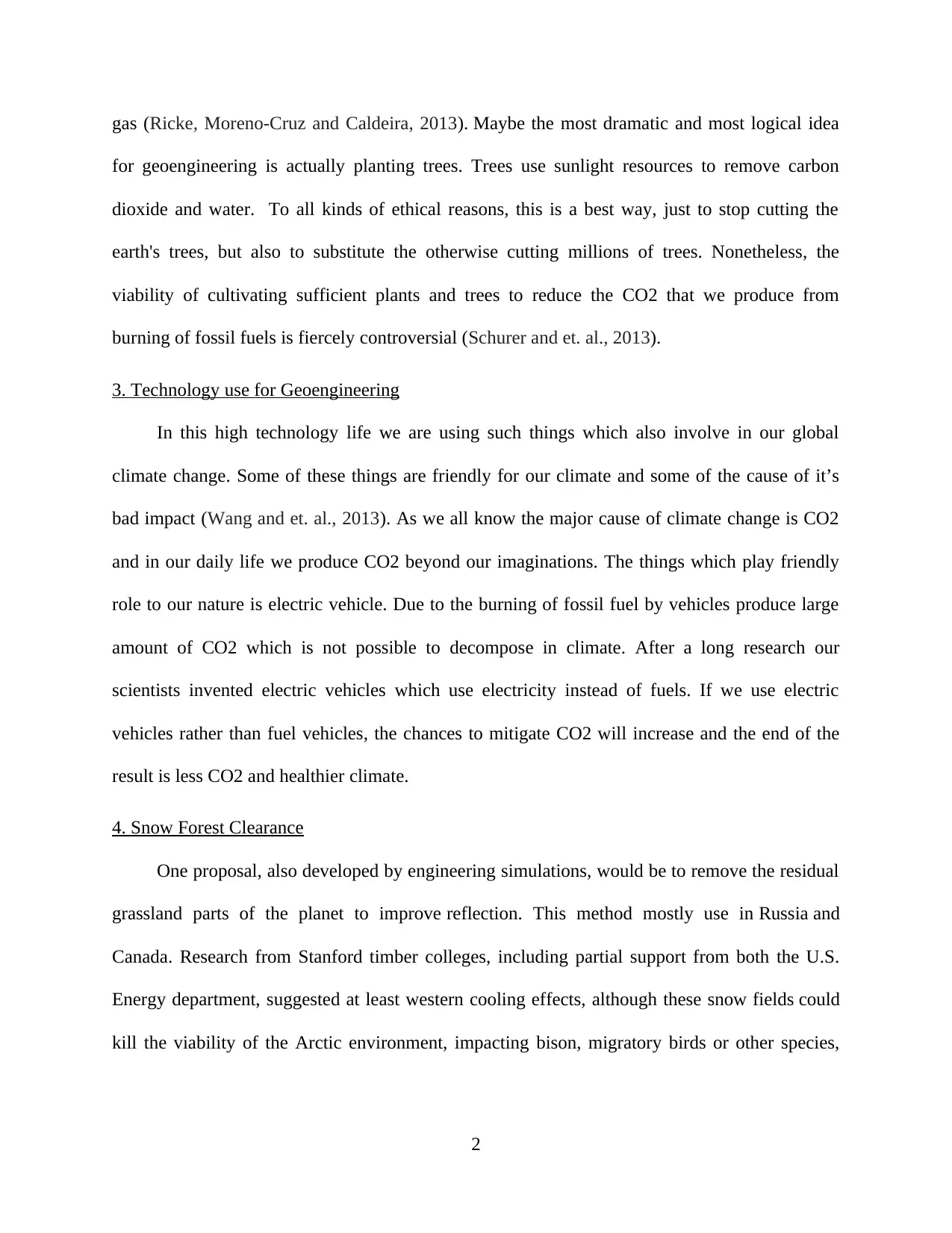
gas (Ricke, Moreno-Cruz and Caldeira, 2013). Maybe the most dramatic and most logical idea
for geoengineering is actually planting trees. Trees use sunlight resources to remove carbon
dioxide and water. To all kinds of ethical reasons, this is a best way, just to stop cutting the
earth's trees, but also to substitute the otherwise cutting millions of trees. Nonetheless, the
viability of cultivating sufficient plants and trees to reduce the CO2 that we produce from
burning of fossil fuels is fiercely controversial (Schurer and et. al., 2013).
3. Technology use for Geoengineering
In this high technology life we are using such things which also involve in our global
climate change. Some of these things are friendly for our climate and some of the cause of it’s
bad impact (Wang and et. al., 2013). As we all know the major cause of climate change is CO2
and in our daily life we produce CO2 beyond our imaginations. The things which play friendly
role to our nature is electric vehicle. Due to the burning of fossil fuel by vehicles produce large
amount of CO2 which is not possible to decompose in climate. After a long research our
scientists invented electric vehicles which use electricity instead of fuels. If we use electric
vehicles rather than fuel vehicles, the chances to mitigate CO2 will increase and the end of the
result is less CO2 and healthier climate.
4. Snow Forest Clearance
One proposal, also developed by engineering simulations, would be to remove the residual
grassland parts of the planet to improve reflection. This method mostly use in Russia and
Canada. Research from Stanford timber colleges, including partial support from both the U.S.
Energy department, suggested at least western cooling effects, although these snow fields could
kill the viability of the Arctic environment, impacting bison, migratory birds or other species,
2
for geoengineering is actually planting trees. Trees use sunlight resources to remove carbon
dioxide and water. To all kinds of ethical reasons, this is a best way, just to stop cutting the
earth's trees, but also to substitute the otherwise cutting millions of trees. Nonetheless, the
viability of cultivating sufficient plants and trees to reduce the CO2 that we produce from
burning of fossil fuels is fiercely controversial (Schurer and et. al., 2013).
3. Technology use for Geoengineering
In this high technology life we are using such things which also involve in our global
climate change. Some of these things are friendly for our climate and some of the cause of it’s
bad impact (Wang and et. al., 2013). As we all know the major cause of climate change is CO2
and in our daily life we produce CO2 beyond our imaginations. The things which play friendly
role to our nature is electric vehicle. Due to the burning of fossil fuel by vehicles produce large
amount of CO2 which is not possible to decompose in climate. After a long research our
scientists invented electric vehicles which use electricity instead of fuels. If we use electric
vehicles rather than fuel vehicles, the chances to mitigate CO2 will increase and the end of the
result is less CO2 and healthier climate.
4. Snow Forest Clearance
One proposal, also developed by engineering simulations, would be to remove the residual
grassland parts of the planet to improve reflection. This method mostly use in Russia and
Canada. Research from Stanford timber colleges, including partial support from both the U.S.
Energy department, suggested at least western cooling effects, although these snow fields could
kill the viability of the Arctic environment, impacting bison, migratory birds or other species,
2
Secure Best Marks with AI Grader
Need help grading? Try our AI Grader for instant feedback on your assignments.
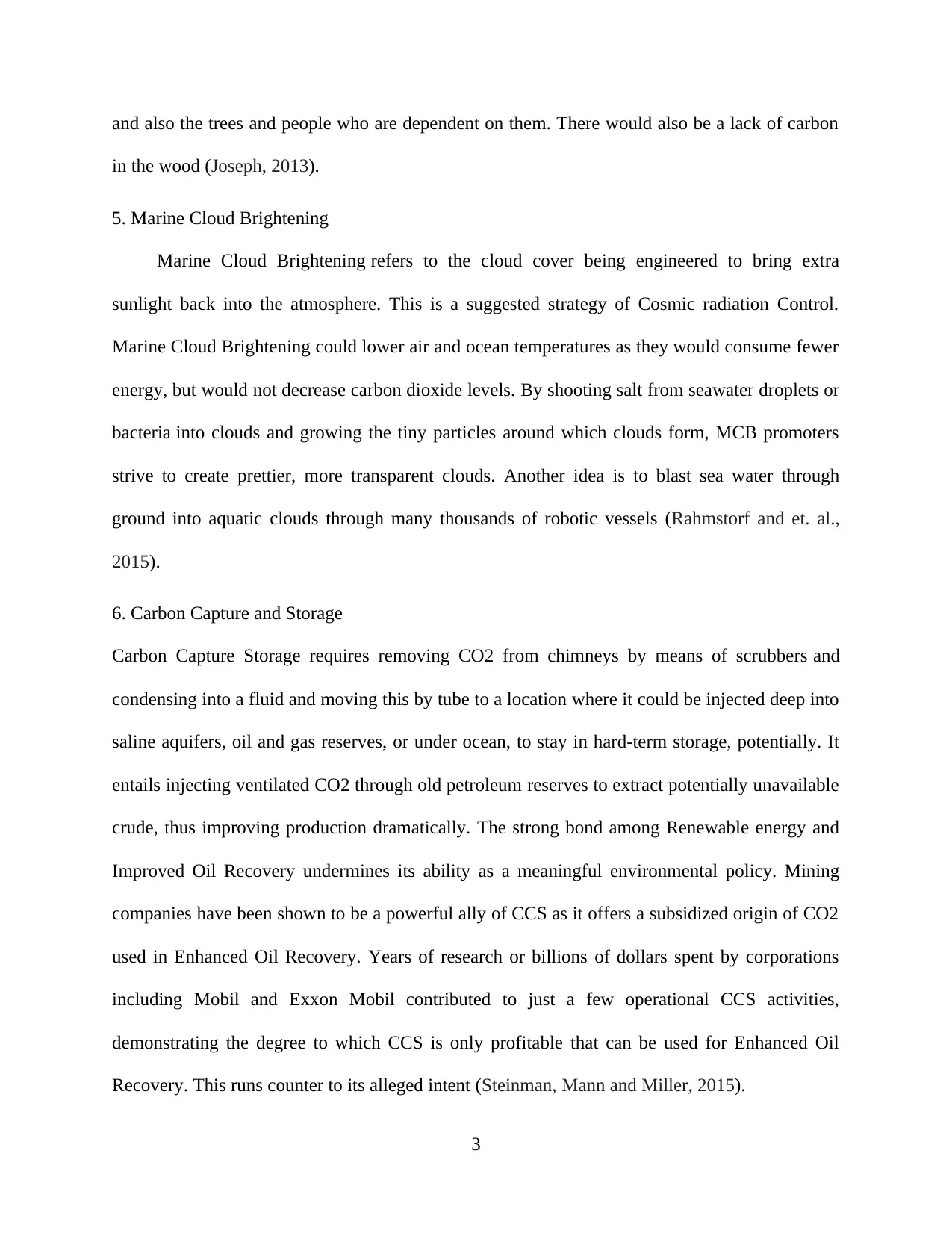
and also the trees and people who are dependent on them. There would also be a lack of carbon
in the wood (Joseph, 2013).
5. Marine Cloud Brightening
Marine Cloud Brightening refers to the cloud cover being engineered to bring extra
sunlight back into the atmosphere. This is a suggested strategy of Cosmic radiation Control.
Marine Cloud Brightening could lower air and ocean temperatures as they would consume fewer
energy, but would not decrease carbon dioxide levels. By shooting salt from seawater droplets or
bacteria into clouds and growing the tiny particles around which clouds form, MCB promoters
strive to create prettier, more transparent clouds. Another idea is to blast sea water through
ground into aquatic clouds through many thousands of robotic vessels (Rahmstorf and et. al.,
2015).
6. Carbon Capture and Storage
Carbon Capture Storage requires removing CO2 from chimneys by means of scrubbers and
condensing into a fluid and moving this by tube to a location where it could be injected deep into
saline aquifers, oil and gas reserves, or under ocean, to stay in hard-term storage, potentially. It
entails injecting ventilated CO2 through old petroleum reserves to extract potentially unavailable
crude, thus improving production dramatically. The strong bond among Renewable energy and
Improved Oil Recovery undermines its ability as a meaningful environmental policy. Mining
companies have been shown to be a powerful ally of CCS as it offers a subsidized origin of CO2
used in Enhanced Oil Recovery. Years of research or billions of dollars spent by corporations
including Mobil and Exxon Mobil contributed to just a few operational CCS activities,
demonstrating the degree to which CCS is only profitable that can be used for Enhanced Oil
Recovery. This runs counter to its alleged intent (Steinman, Mann and Miller, 2015).
3
in the wood (Joseph, 2013).
5. Marine Cloud Brightening
Marine Cloud Brightening refers to the cloud cover being engineered to bring extra
sunlight back into the atmosphere. This is a suggested strategy of Cosmic radiation Control.
Marine Cloud Brightening could lower air and ocean temperatures as they would consume fewer
energy, but would not decrease carbon dioxide levels. By shooting salt from seawater droplets or
bacteria into clouds and growing the tiny particles around which clouds form, MCB promoters
strive to create prettier, more transparent clouds. Another idea is to blast sea water through
ground into aquatic clouds through many thousands of robotic vessels (Rahmstorf and et. al.,
2015).
6. Carbon Capture and Storage
Carbon Capture Storage requires removing CO2 from chimneys by means of scrubbers and
condensing into a fluid and moving this by tube to a location where it could be injected deep into
saline aquifers, oil and gas reserves, or under ocean, to stay in hard-term storage, potentially. It
entails injecting ventilated CO2 through old petroleum reserves to extract potentially unavailable
crude, thus improving production dramatically. The strong bond among Renewable energy and
Improved Oil Recovery undermines its ability as a meaningful environmental policy. Mining
companies have been shown to be a powerful ally of CCS as it offers a subsidized origin of CO2
used in Enhanced Oil Recovery. Years of research or billions of dollars spent by corporations
including Mobil and Exxon Mobil contributed to just a few operational CCS activities,
demonstrating the degree to which CCS is only profitable that can be used for Enhanced Oil
Recovery. This runs counter to its alleged intent (Steinman, Mann and Miller, 2015).
3
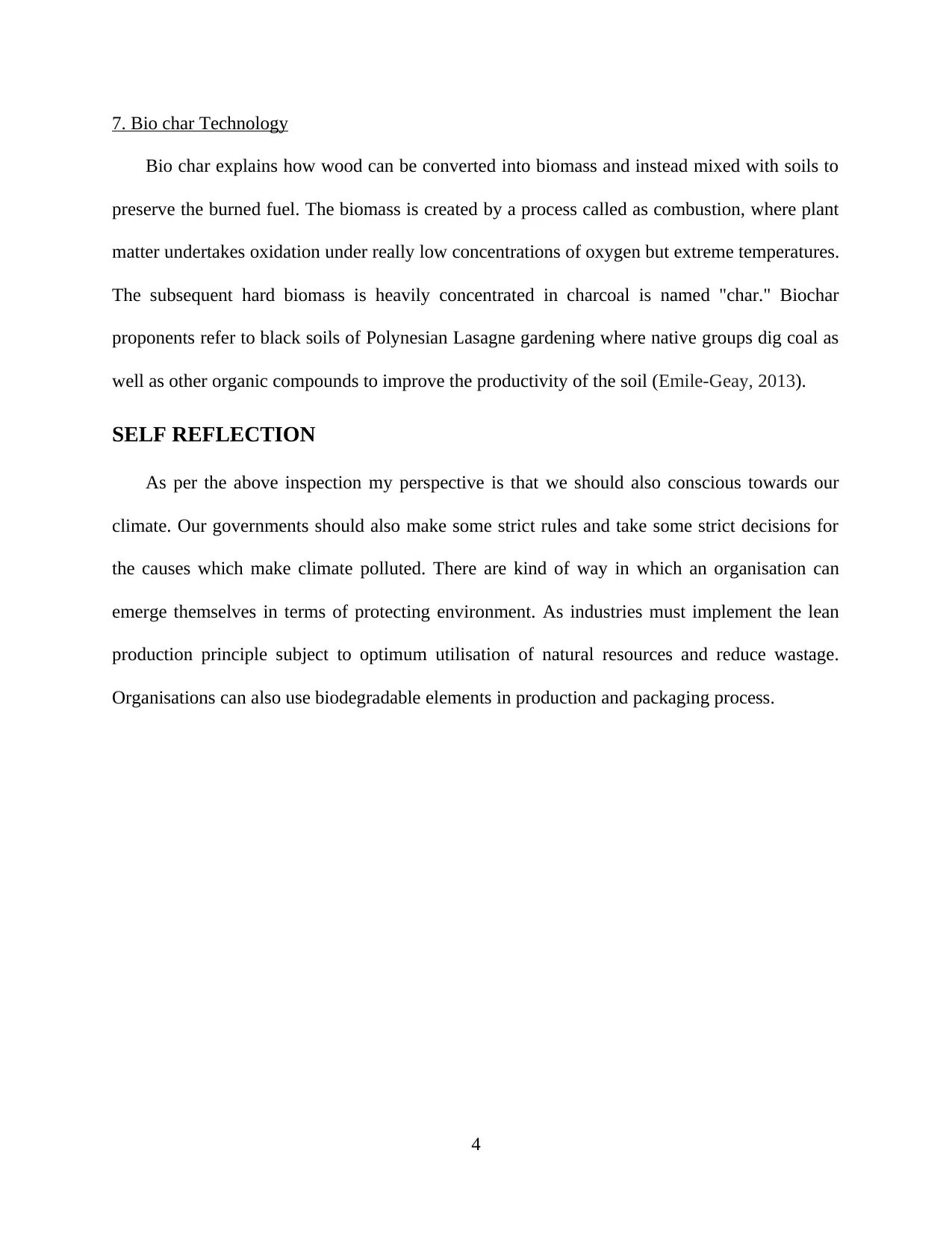
7. Bio char Technology
Bio char explains how wood can be converted into biomass and instead mixed with soils to
preserve the burned fuel. The biomass is created by a process called as combustion, where plant
matter undertakes oxidation under really low concentrations of oxygen but extreme temperatures.
The subsequent hard biomass is heavily concentrated in charcoal is named "char." Biochar
proponents refer to black soils of Polynesian Lasagne gardening where native groups dig coal as
well as other organic compounds to improve the productivity of the soil (Emile-Geay, 2013).
SELF REFLECTION
As per the above inspection my perspective is that we should also conscious towards our
climate. Our governments should also make some strict rules and take some strict decisions for
the causes which make climate polluted. There are kind of way in which an organisation can
emerge themselves in terms of protecting environment. As industries must implement the lean
production principle subject to optimum utilisation of natural resources and reduce wastage.
Organisations can also use biodegradable elements in production and packaging process.
4
Bio char explains how wood can be converted into biomass and instead mixed with soils to
preserve the burned fuel. The biomass is created by a process called as combustion, where plant
matter undertakes oxidation under really low concentrations of oxygen but extreme temperatures.
The subsequent hard biomass is heavily concentrated in charcoal is named "char." Biochar
proponents refer to black soils of Polynesian Lasagne gardening where native groups dig coal as
well as other organic compounds to improve the productivity of the soil (Emile-Geay, 2013).
SELF REFLECTION
As per the above inspection my perspective is that we should also conscious towards our
climate. Our governments should also make some strict rules and take some strict decisions for
the causes which make climate polluted. There are kind of way in which an organisation can
emerge themselves in terms of protecting environment. As industries must implement the lean
production principle subject to optimum utilisation of natural resources and reduce wastage.
Organisations can also use biodegradable elements in production and packaging process.
4
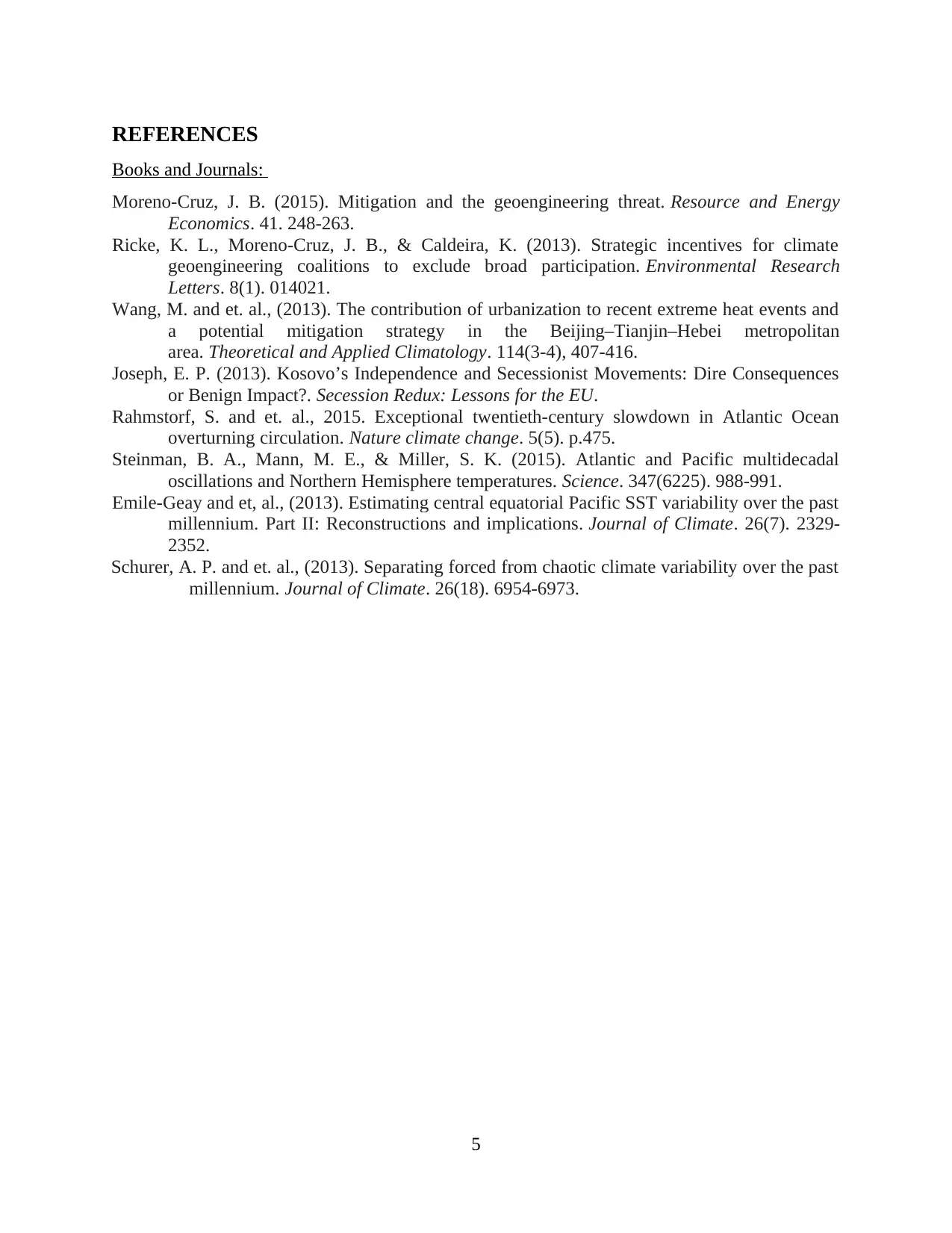
REFERENCES
Books and Journals:
Moreno-Cruz, J. B. (2015). Mitigation and the geoengineering threat. Resource and Energy
Economics. 41. 248-263.
Ricke, K. L., Moreno-Cruz, J. B., & Caldeira, K. (2013). Strategic incentives for climate
geoengineering coalitions to exclude broad participation. Environmental Research
Letters. 8(1). 014021.
Wang, M. and et. al., (2013). The contribution of urbanization to recent extreme heat events and
a potential mitigation strategy in the Beijing–Tianjin–Hebei metropolitan
area. Theoretical and Applied Climatology. 114(3-4), 407-416.
Joseph, E. P. (2013). Kosovo’s Independence and Secessionist Movements: Dire Consequences
or Benign Impact?. Secession Redux: Lessons for the EU.
Rahmstorf, S. and et. al., 2015. Exceptional twentieth-century slowdown in Atlantic Ocean
overturning circulation. Nature climate change. 5(5). p.475.
Steinman, B. A., Mann, M. E., & Miller, S. K. (2015). Atlantic and Pacific multidecadal
oscillations and Northern Hemisphere temperatures. Science. 347(6225). 988-991.
Emile-Geay and et, al., (2013). Estimating central equatorial Pacific SST variability over the past
millennium. Part II: Reconstructions and implications. Journal of Climate. 26(7). 2329-
2352.
Schurer, A. P. and et. al., (2013). Separating forced from chaotic climate variability over the past
millennium. Journal of Climate. 26(18). 6954-6973.
5
Books and Journals:
Moreno-Cruz, J. B. (2015). Mitigation and the geoengineering threat. Resource and Energy
Economics. 41. 248-263.
Ricke, K. L., Moreno-Cruz, J. B., & Caldeira, K. (2013). Strategic incentives for climate
geoengineering coalitions to exclude broad participation. Environmental Research
Letters. 8(1). 014021.
Wang, M. and et. al., (2013). The contribution of urbanization to recent extreme heat events and
a potential mitigation strategy in the Beijing–Tianjin–Hebei metropolitan
area. Theoretical and Applied Climatology. 114(3-4), 407-416.
Joseph, E. P. (2013). Kosovo’s Independence and Secessionist Movements: Dire Consequences
or Benign Impact?. Secession Redux: Lessons for the EU.
Rahmstorf, S. and et. al., 2015. Exceptional twentieth-century slowdown in Atlantic Ocean
overturning circulation. Nature climate change. 5(5). p.475.
Steinman, B. A., Mann, M. E., & Miller, S. K. (2015). Atlantic and Pacific multidecadal
oscillations and Northern Hemisphere temperatures. Science. 347(6225). 988-991.
Emile-Geay and et, al., (2013). Estimating central equatorial Pacific SST variability over the past
millennium. Part II: Reconstructions and implications. Journal of Climate. 26(7). 2329-
2352.
Schurer, A. P. and et. al., (2013). Separating forced from chaotic climate variability over the past
millennium. Journal of Climate. 26(18). 6954-6973.
5
1 out of 7
Related Documents
Your All-in-One AI-Powered Toolkit for Academic Success.
+13062052269
info@desklib.com
Available 24*7 on WhatsApp / Email
![[object Object]](/_next/static/media/star-bottom.7253800d.svg)
Unlock your academic potential
© 2024 | Zucol Services PVT LTD | All rights reserved.




